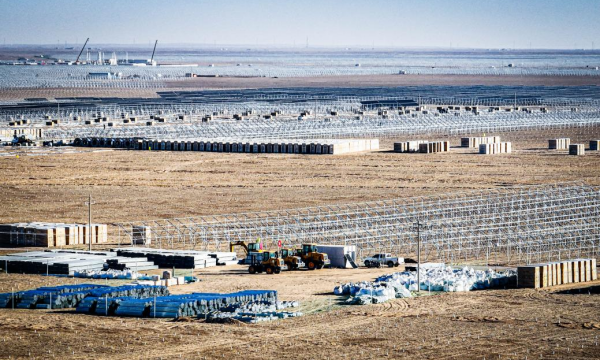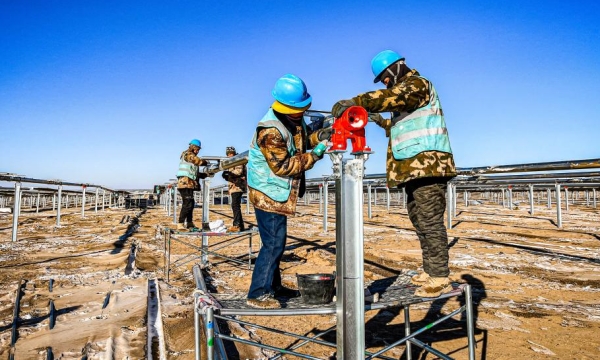In the hinterland of the Maowusu Desert on the border of Inner Mongolia Autonomous Region, Shaanxi Province, and Ningxia Hui Autonomous Region, construction of a 3 million-kilowatt photovoltaic (PV) base is underway.

A view of CHN Energy Investment Group Co., LTD’s 3 million-kilowatt photovoltaic base in the Maowusu Desert on the border of Inner Mongolia Autonomous Region, Shaanxi Province, and Ningxia Hui Autonomous Region [Photo/sasac.gov.cn]
Developed by CHN Energy Investment Group Co., LTD (CHN Energy), the PV base is one of the second group of China’s large-scale PV base projects built in the desert and Gobi areas.

Workers install a component onto the H-shaped supports at the CHN Energy Investment Group Co., LTD’s 3 million-kilowatt photovoltaic base in the Maowusu Desert. It is the first time such supports have been widely used in China. [Photo/sasac.gov.cn]
Covering an area of 105,000 mu, the project is expected to annually export nearly 5.7 billion units of green power from West Inner Mongolia to the shore of the Yellow Sea in East China.
It will effectively relieve power shortages in East China’s Shandong Province and provide strong green power support to economic and social development in East China.
The project is equipped with six unmanned 220-kilovolt booster stations. The booster stations were built in a prefabricated cabin form, which effectively avoided impact of the weather on the construction and accelerated the construction progress.
By using single-axis tracking systems for PV modules, the modules can track the sunlight like sunflowers, increasing the power generation efficiency by approximately 8 percent.

Workers fix the PV components at the CHN Energy Investment Group Co., LTD’s 3 million-kilowatt photovoltaic base in the Maowusu Desert. It is the first time such supports have been widely used in China. [Photo/sasac.gov.cn]
So far, construction of the pile foundations with capacity of 1.75 million kW has been completed and building of the supports with capacity of 650,000 kW and assembly of the 250,000-kW components are underway.
The first booster station is now ready for operation.
(Executive editor: Zhu Zeya)